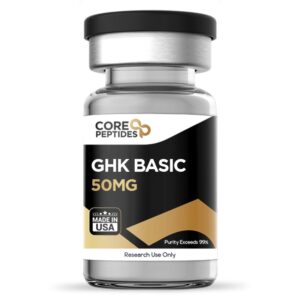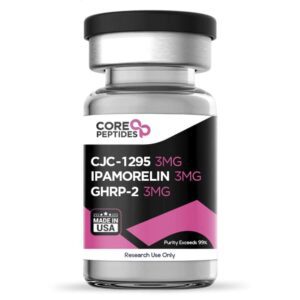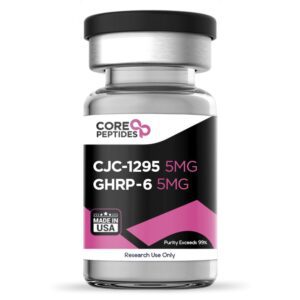Description
Fragment 176-191 & Mod GRF 1-29 & Ipamorelin Peptide Blend is a synergistic combination of three research peptides—each with unique mechanisms that may support growth hormone (GH) release, fat metabolism, and regenerative processes in scientific models. Designed exclusively for research and laboratory use, this blend has gained attention in scientific communities for its potential role in lipolysis, metabolic modulation, and cellular regeneration.
Component Overview
Modified GRF 1-29 (CJC-1295 without DAC)
Modified GRF 1-29 is a truncated analog of Growth Hormone-Releasing Hormone (GHRH), containing 29 amino acids. Four amino acids have been modified to increase its resistance to DPP-4 enzyme degradation, thereby extending its biological half-life. These modifications may enhance the peptide’s stability and support consistent GH release in experimental models.
Ipamorelin
Ipamorelin is a selective Growth Hormone Secretagogue Receptor (GHSR-1a) agonist, derived from GHRP-1. Research indicates that Ipamorelin may stimulate the natural release of growth hormone from somatotroph cells without significantly influencing cortisol or prolactin levels. By mimicking the activity of ghrelin, it appears to induce GH secretion through pituitary receptor activation and calcium channel signaling pathways.
Fragment 176-191 (AOD 9604)
Fragment 176-191, often referred to as the “fat-burning peptide,” is a modified section of the human growth hormone (hGH) sequence consisting of the last 16 amino acids (177–191) with an additional tyrosine residue. Studies suggest that it may exert lipolytic effects independent of GH receptors, potentially enhancing fat oxidation and metabolism through beta-adrenergic receptor pathways.
Chemical Information
| Peptide | Molecular Formula | Molecular Weight | Other Names |
|---|---|---|---|
| Fragment 176-191 | C₇₈H₁₂₅N₂₃O₂₃S₂ | 1817.12 g/mol | AOD 9604, GH Lipolytic Fragment |
| Modified GRF 1-29 | C₁₅₂H₂₅₂N₄₄O₄₂ | 3367.9 g/mol | Mod GRF 1-29, CJC-1295 (without DAC) |
| Ipamorelin | C₃₈H₄₉N₉O₅ | 711.8 g/mol | Ipamorelin Acetate, IPA |
Research Overview
Lipolytic and Metabolic Research
Among the three peptides, Fragment 176-191 is recognized for its potential lipolytic (fat-reducing) effects. Research on obese murine models showed significant reductions in body weight and fat mass following two weeks of peptide administration (Heffernan et al., 2001). These effects may be linked to increased β3-adrenergic receptor expression, suggesting a mechanism involving enhanced lipid oxidation rather than receptor-mediated lipolysis alone.
A 12-week clinical trial (News Medical, 2004) involving 300 obese participants found that subjects receiving Fragment 176-191 experienced up to 2.8 kg of weight reduction, improved glucose tolerance, and favorable lipid profiles — all with minimal side effects.
Growth Hormone Release and Pituitary Function
Mod GRF 1-29 and Ipamorelin may act synergistically to stimulate endogenous GH release. Ipamorelin binds to GHSR-1a receptors, triggering intracellular calcium influx and GH secretion from somatotroph cells. Meanwhile, Mod GRF 1-29 binds to GHRH receptors, activating the adenylyl cyclase/cAMP pathway that enhances GH synthesis and release. Together, they may potentiate GH output more effectively than either peptide alone, offering promising models for studying pituitary gland signaling and GH modulation (Sigalos & Pastuszak, 2018).
Regeneration and Cartilage Repair
In a 2015 rabbit study (Kwon & Park, 2015), intra-articular administration of Fragment 176-191 (AOD 9604), particularly when combined with hyaluronic acid, showed promising effects on cartilage regeneration. The group treated with the peptide blend displayed reduced cartilage degeneration and enhanced joint structure restoration, suggesting potential use in orthopedic regeneration studies.
Bone Mineralization and Muscle Integrity
Experimental studies involving Ipamorelin have indicated potential benefits for bone density and muscle preservation. In murine models, Ipamorelin administration was correlated with improved bone mineral content (BMC) and tibial/vertebral bone density, potentially linked to enhanced osteoblastic activity and muscle strength under catabolic conditions (Bialek et al., 2001; Svensson et al., 2002).
Appetite and Energy Regulation
Ipamorelin’s activation of ghrelin receptors may also impact appetite regulation. Animal studies observed approximately 15% weight gain and elevated serum leptin levels following Ipamorelin administration, suggesting a possible increase in caloric intake and fat storage. These findings highlight the peptide’s role in studying energy balance and feeding behavior mechanisms in controlled laboratory settings (Tolle et al., 2002).
Certificate of Analysis (COA)
Each batch of Fragment 176-191 & Mod GRF 1-29 & Ipamorelin Peptide Blend undergoes rigorous HPLC and Mass Spectrometry testing to confirm sequence accuracy, purity (>99%), and molecular integrity. Certificates of Analysis are provided with every order to ensure reproducibility and traceability of research-grade standards.
HPLC
High-Performance Liquid Chromatography (HPLC) verifies >99% purity, confirming the absence of degradation products or contaminants. Consistency in chromatographic profiles ensures that researchers receive high-quality peptide material suitable for precise and reproducible laboratory work.
Mass Spectrometry
Mass spectrometry confirms the molecular weights of each peptide and validates the amino acid sequence integrity. This analytical process guarantees molecular precision and quality assurance for reliable research outcomes.
Intended Use
This peptide blend is supplied for research and laboratory purposes only.
Not for human consumption, therapeutic use, or veterinary application. Researchers should handle according to institutional safety and compliance guidelines.
References
-
NCBI. PubChem Compound Summary for CID 91976842, CJC1295 Without DAC (2023).
-
Heffernan M et al. Endocrinology. 2001;142(12):5182–5189.
-
NCBI. PubChem Substance Record for SID 319360420, 386264-39-7. (2023).
-
NCBI. PubChem Compound Summary for CID 9831659, Ipamorelin. (2023).
-
Sigalos JT, Pastuszak AW. Sexual Medicine Reviews. 2018;6(1):45–53.
-
News Medical. “Obesity Drug AOD9604 Highly Successful in Trials.” (2004).
-
Kwon DR, Park GY. Ann Rehabil Med. 2015;39(3):379–389.
-
Bialek P et al. Endocrinology. 2001;142(12):5647–5654.
-
Svensson J et al. J Bone Miner Res. 2002;17(6):987–993.
-
Tolle V et al. Neuroendocrinology. 2002;76(5):327–338.





Reviews
There are no reviews yet.